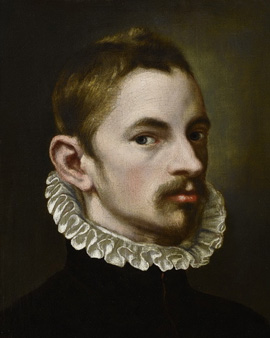Bartolomeo Passarotti had gained an important reputation as a painter and etcher in Renaissance Italy. He is particularly regarded as a protagonist of the cinquecento as a way of depicting the concept of beauty typical of the period in painting.
There is almost no information about the centuries of Bartolomeo Passarotti's youth; the first evidence of his career dates back to 1551, when he left his birthplace Bologna to study and work in Rome with the late Renaissance architect Jacopo Barozzi da Vignola and the Mannerist painter Taddeo Zuccari. At that time, he was influenced by the architect's structured approach as well as his focus on individual artistic style with a capricious and tense style. Returning to Bologna, Bartolomeo Passarotti opened his own large workshop in 1565. In painting, he cultivated the style of the so-called Venetian school with a special focus on colouring. Among other artists, Passarotti trained the painter and engraver Agostino Carracci. At the same time he painted still lifes, portraits and religious motifs, which today can be seen mainly in Bologna's churches, for example in the Basilica of San Giacomo Maggiore.
Passarotti's portraits are regarded as an expression of the incipient Baroque in art, which is nevertheless based on the traditions of the Renaissance. At this time Passarotti was artistically influenced by Girolamo Francesco Maria Mazzola, called Parmigianino and by Antonio da Correggio. It was precisely his portraits that helped Bartolomeo Passarotti to gain the reputation of being the most important portraitist of Bologna in the late 16th century. He made use of a particularly charming use of colour - what became characteristic, however, was the extremely lively art of characterisation, an outstanding feature of the cinquecento in the Italian art of that time.
In his representations the master cultivated the concept of beauty of the Italian Cinquecento. The cinquecento style is regarded as a further development of the quattrocento with its austere, modest depictions to radiantly elaborated motifs. Thus Bartolomeo Passerotti devoted himself on the one hand to mythological and religious themes and on the other hand to a true-to-life portrait art with the representation of folk types taken from real life. The certain pathos with which the representational was understood cannot be overlooked. A characteristic feature of his later portrait painting is, among other things, a lively play of the hands. It enlivens the action up to the dramatic. In addition, Bartolomeo Passarotti captivates with his carefully worked-out physiognomy, both in the religious depictions and in the characterizing images of the people of his time.
×





.jpg)
.jpg)
.jpg)
.jpg)
.jpg)
.jpg)
_-_(MeisterDrucke-1107299).jpg)
_-_(MeisterDrucke-1107299).jpg)
 - (MeisterDrucke-50303).jpg)
 - (MeisterDrucke-50303).jpg)
.jpg)
.jpg)
.jpg)
.jpg)
.jpg)
.jpg)
![Aeneas and Anchises [?] by Bartolomeo Passarotti Aeneas and Anchises [?] by Bartolomeo Passarotti](/kunstwerke/300px/Bartolomeo_Passarotti_-_Aenes_og_Anchises_-_(MeisterDrucke-1262631).jpg)
![Aeneas and Anchises [?] by Bartolomeo Passarotti](/kunstwerke/400w/Bartolomeo_Passarotti_-_Aenes_og_Anchises_-_(MeisterDrucke-1262631).jpg)
.jpg)
.jpg)
.jpg)
.jpg)
_-_(MeisterDrucke-911412).jpg)
_-_(MeisterDrucke-911412).jpg)
.jpg)
.jpg)
.jpg)
.jpg)
.jpg)
.jpg)
.jpg)
.jpg)
.jpg)
.jpg)
.jpg)
.jpg)
.jpg)
.jpg)
.jpg)
.jpg)
.jpg)
.jpg)
.jpg)
.jpg)
.jpg)
.jpg)
.jpg)
.jpg)
_Details_of_a_Nude_Male_Child_-_(MeisterDrucke-1612319).jpg)
_Details_of_a_Nude_Male_Child_-_(MeisterDrucke-1612319).jpg)
.jpg)
.jpg)
.jpg)
.jpg)
.jpg)
.jpg)
.jpg)
.jpg)
.jpg)
.jpg)
.jpg)
.jpg)
.jpg)
.jpg)
.jpg)
.jpg)
.jpg)
.jpg)
_-_(MeisterDrucke-1092706).jpg)
_-_(MeisterDrucke-1092706).jpg)
.jpg)
.jpg)
.jpg)
.jpg)
 - (MeisterDrucke-145919).jpg)
 - (MeisterDrucke-145919).jpg)
.jpg)
.jpg)
.jpg)
.jpg)
.jpg)
.jpg)
_-_(MeisterDrucke-1440506).jpg)
_-_(MeisterDrucke-1440506).jpg)
.jpg)
.jpg)
.jpg)
.jpg)
.jpg)
.jpg)
.jpg)
.jpg)
.jpg)
.jpg)
.jpg)
.jpg)
.jpg)
.jpg)
.jpg)
.jpg)
.jpg)
.jpg)
.jpg)
.jpg)
.jpg)
.jpg)
.jpg)
.jpg)
.jpg)
.jpg)
.jpg)
.jpg)
_-_(MeisterDrucke-1091033).jpg)
_-_(MeisterDrucke-1091033).jpg)
.jpg)
.jpg)






